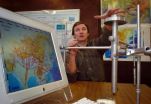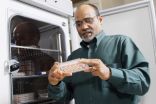(Press-News.org) WEST LAFAYETTE, Ind. - Researchers found a previously unmapped fault was responsible for the devastating Jan. 12 earthquake in Haiti and that the originally blamed fault remains ready to produce a large earthquake.
Eric Calais, a Purdue University professor of earth and atmospheric sciences, led the team that was the first on the ground in Haiti after the magnitude 7.0 earthquake, which killed more than 200,000 people and left 1.5 million homeless.
The team determined the earthquake's origin is a previously unmapped fault, which they named the LÄogëne fault. The newly discovered fault runs almost parallel to the Enriquillo fault, which was originally thought to be the source of the earthquake, he said.
"This means that the Enriquillo fault is still capable of producing large earthquakes and that Haiti has to adapt to this seismic hazard," said Calais, who in September was appointed science adviser for the United Nations Development Program in Haiti. "The fault system is more complex than we originally thought, and we don't yet know how the January earthquake impacted the other faults. Preliminary measurements indicate that the Enriquillo fault did not release any accumulated seismic energy and, therefore, remains a significant threat for Haiti, and Port-au-Prince in particular. We need to investigate the fault system further to be able to determine where the next earthquakes might occur and how large they could be."
The shifting of the Earth's crust after a major earthquake can add to or reduce stresses building up in nearby faults and can apply pressures that effectively stop or release other earthquakes. Because of this, the earthquake along the Léogâne fault may have delayed or advanced the timing for the next earthquake on the Enriquillo fault, he said.
"For practical purposes, speculating on when the next earthquake might happen is not an effective strategy," Calais said. "We rather need to focus attention, energy and funds on proactive measures to help the country adapt to earthquake hazards and, eventually, reduce economic losses and save lives. Our finding raises many important scientific questions and we are working to find the answers, but we already know that the earthquake threat in Haiti is inexorable. The reconstruction process that is now starting in Haiti is an opportunity to build better, of course, but also to develop an effective prevention and mitigation strategy for the future."
The team analyzed data they recorded before the Jan. 12 earthquake and new measurements taken after the event. Their work is detailed in a paper that will be published in the November issue of Nature Geosciences.
Andrew Freed, paper co-author and a Purdue professor of earth and atmospheric sciences, said the absence of any surface rupture was the first clue that the earthquake did not happen along the Enriquillo fault.
"It was a big surprise that we couldn't find a surface rupture anywhere," Freed said. "We did find other physical changes that we expected after an earthquake of that magnitude, but in entirely the wrong location to have come from the Enriquillo fault."
For instance the team found that the epicenter area rose by a little more than half a meter and that the earthquake caused contraction of the Earth's crust opposite of what would be expected from the Enriquillo fault, he said.
The team used global positioning system equipment and radar interferometry to measure how the ground moved during the earthquake, which provides insight into what is happening as much as 20 kilometers below the surface. The team then used a computer model to determine what characteristics the source of the earthquake must have in order to produce the observed changes.
Through this work, the team discovered the previously unmapped Léogâne fault, which is located just to the north of the Enriquillo fault and dips by a 60-degree angle to the north. The fault is a blind thrust, meaning one side of the fault is being thrust over the other, but the fault does not reach the surface.
About 30 kilometers of the fault shifted during the January earthquake, and the sides of the fault moved by as much as five meters relative to each other below the Earth's surface. The full length of the fault is not known, Freed said.
"Only portions of a fault are affected during any given earthquake, and the length of the portion affected is relative to the magnitude of the event," Freed said. "Because this is a blind fault, we don't have some of the clues at the surface, like scars from past ruptures, that show where the fault runs. On the Enriquillo fault you can almost walk the line of the fault because scars from many past events reveal the fault below. That isn't the case with the Léogâne fault."
The team plans to continue to take measurements of the postseismic processes that allow them to understand changing stresses within the Earth's crust over time that could help point to areas where seismic hazard is increasing. In addition they plan to create models to better understand the fault systems, their behavior and why they exist at these particular locations, Freed said.
In addition to Freed, co-authors include Glen Mattioli of the University of Arkansas; Falk Amelung, Sang-Hoon Hong and Timothy Dixon of the University of Miami; Sigurjùn Jùnsson of the King Abdullah University of Science and Technology in Saudi Arabia; Pamela Jansma of the University of Texas at Arlington; Claude PrÄpetit of the Bureau of Mines in Haiti; and Roberte Momplaisir of the State University of Haiti.
Calais has studied the Enriquillo and Septentrional faults on the island of Hispaniola, which includes Haiti and the Dominican Republic, since 1989. His research team has been measuring the build up of energy along these faults using global positioning system technology for 10 years. The team first reported the risk for a major earthquake there in 2008.
INFORMATION:
This work was funded by the National Science Foundation and the National Disaster Risk Management System Development Program of the United Nations Development Program in Haiti. It was performed in collaboration with, and in support to, the Haitian National System for Disaster Risk Reduction.
Writer: Elizabeth K. Gardner, 765-494-2081, ekgardner@purdue.edu
Sources: Eric Calais, ecalais@purdue.edu
Andrew Freed, freed@purdue.edu
Related websites:
Eric Calais: http://web.ics.purdue.edu/~ecalais/
Andrew Freed: http://www.purdue.edu/eas/freed/index.html
PHOTO CAPTION:
Eric Calais, a Purdue professor of geophysics, shows GPS equipment used to track movements of the Earth's surface as small as one millimeter. These tiny movements show the build up of stress that could lead to an earthquake and are used in evaluating the potential threat to an area. (Purdue News Service file photo/David Umberger)
A publication-quality file photo is available at http://news.uns.purdue.edu/images/+2007/calais-GPS.jpg
Abstract on the research in this release is available at: http://www.purdue.edu/newsroom/research/2010/101025CalaisFreedHaiti.html
Purdue-led research team finds Haiti quake caused by unknown fault
2010-10-26
ELSE PRESS RELEASES FROM THIS DATE:
Substantial consumption of fluoride increases chance of mild fluorosis
2010-10-26
CHICAGO, Oct. 25, 2010 – Young children who consume substantial amounts of fluoride through infant formula and other beverages mixed with fluoridated water or by swallowing fluoride toothpaste have an increased chance of developing mild enamel fluorosis, according to research published in the October issue of The Journal of the American Dental Association and supported by the National Institute of Dental and Craniofacial Research. Children can continue using fluoridated water and fluoride toothpaste because fluoride has been proven to prevent tooth decay, and mild fluorosis ...
MicroRNAs dictate the Epstein-Barr virus' elaborate waiting game, cancer formation
2010-10-26
While most commonly associated with mononucleosis, Epstein-Barr virus (EBV) has been linked to many diseases that affect people long after the initial infection takes place, including some forms of cancer. In the current issue of the Journal of Biological Chemistry, scientists at The Wistar Institute describe how viral microRNA – small segments of RNA that suppress the effects of gene activity – allows EBV to hide within cells and evade the immune system. The scientists believe their findings may one day enable physicians to flush EBV out of hiding, allowing a healthy immune ...
Researchers find a stable way to store the sun's heat
2010-10-26
CAMBRIDGE, Mass. -- Researchers at MIT have revealed exactly how a molecule called fulvalene diruthenium, which was discovered in 1996, works to store and release heat on demand. This understanding, reported in a paper published on Oct. 20 in the journal Angewandte Chemie, should make it possible to find similar chemicals based on more abundant, less expensive materials than ruthenium, and this could form the basis of a rechargeable battery to store heat rather than electricity.
The molecule undergoes a structural transformation when it absorbs sunlight, putting it into ...
Listeria clever at finding its way into bloodstream, causing sickness
2010-10-26
WEST LAFAYETTE, Ind. - Pathogenic listeria tricks intestinal cells into helping it pass through those cells to make people ill, and, if that doesn't work, the bacteria simply goes around the cells, according to a Purdue University study.
Arun Bhunia, a professor of food science, and Kristin Burkholder, a former Purdue graduate student who is now a postdoctoral researcher in microbiology and immunology at the University of Michigan Medical School, found that listeria, even in low doses, somehow triggers intestinal cells to express a new protein, heat shock protein 60, ...
Modern humans emerged far earlier than previously thought
2010-10-26
An international team of researchers based at the Institute of Vertebrate Paleontology and Paleoanthropology in Beijing, including a physical anthropology professor at Washington University in St. Louis, has discovered well-dated human fossils in southern China that markedly change anthropologists perceptions of the emergence of modern humans in the eastern Old World.
The research was published Oct. 25 in the online early edition of the Proceedings of the National Academy of Sciences.
The discovery of early modern human fossil remains in the Zhirendong (Zhiren Cave) ...
'Fracking' mobilizes uranium in marcellus shale
2010-10-26
BUFFALO, N.Y. -- Scientific and political disputes over drilling Marcellus shale for natural gas have focused primarily on the environmental effects of pumping millions of gallons of water and chemicals deep underground to blast through rocks to release the natural gas.
But University at Buffalo researchers have now found that that process -- called hydraulic fracturing or "fracking"-- also causes uranium that is naturally trapped inside Marcellus shale to be released, raising additional environmental concerns.
The research will be presented at the annual meeting of ...
Study finds race, ethnicity impact access to care for children with frequent ear infections
2010-10-26
Ear infections are one of the most common health problems for children, with most kids experiencing at least one by their third birthday. Annual costs in the United States alone are in the billions of dollars.
When these infections are left untreated, complications can include hearing loss, speech problems and more severe infections that can spread to bone and brain, causing meningitis. But not all kids have the same access to medical specialists and medicines.
A new study by researchers at the David Geffen School of Medicine at UCLA and Harvard Medical School has ...
Knowledge gaps, fears common among parents of children with drug-resistant bacteria
2010-10-26
Knowledge gaps and fear — some of it unjustified — are common among the caregivers of children with a drug-resistant staph bacterium known as MRSA, according to the results of a small study from the Johns Hopkins Children Center. These caregivers thirst for timely, detailed and simple information, the researchers add.
The study's findings, published online in The Journal of Pediatrics, underscore the need for healthcare staff to do a better job in educating parents, while also addressing concerns and allaying fears, the investigators say.
"What these results really ...
Growing crops in the city
2010-10-26
Madison, WI, October 25, 2010 – A case study published in the 2010 Journal of Natural Resources and Life Sciences Education by professors at Washington State University studies the challenges one organization faced in maintaining an urban market garden. The journal is published by the American Society of Agronomy.
Since 1995, Seattle Youth Garden Works (SYGW) has employed young homeless individuals or those involved in the juvenile justice system. SYGW offers teens and young adults the opportunity to work, develop social skills, and eventually find stable employment or ...
Newfoundland researchers crack the genetic code of a sudden death cardiac killer
2010-10-26
Montreal – Researchers in Newfoundland have cracked the genetic code of a sudden death cardiac killer.
As a result, they have developed a unique prevention program in which people with no symptoms, but with a suspect gene and a family history, are being implanted with internal cardiac defibrillators (ICDs) which can restart their hearts if they stop.
"Our discovery has led to a targeted genetic screening and individualized therapy that is significantly improving survival rates," Dr. Sean Connors told the Canadian Cardiovascular Congress 2010, co-hosted by the Heart ...


